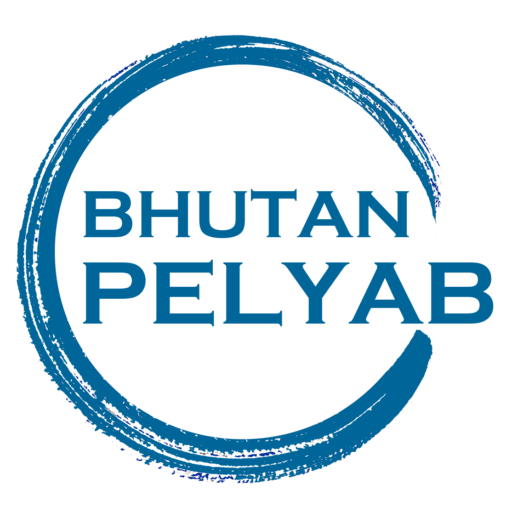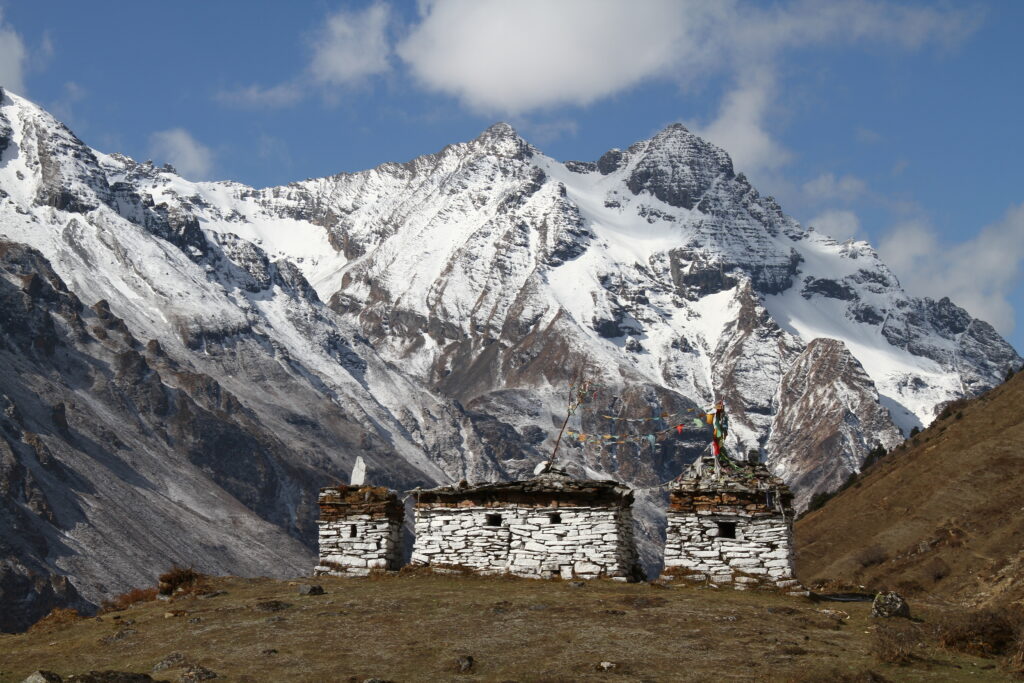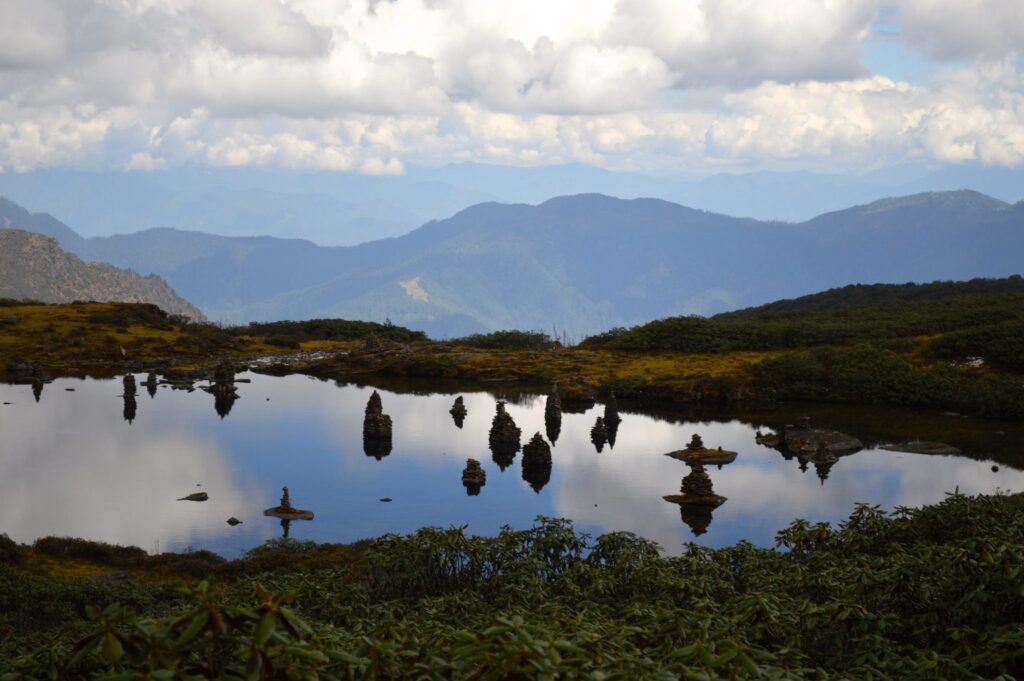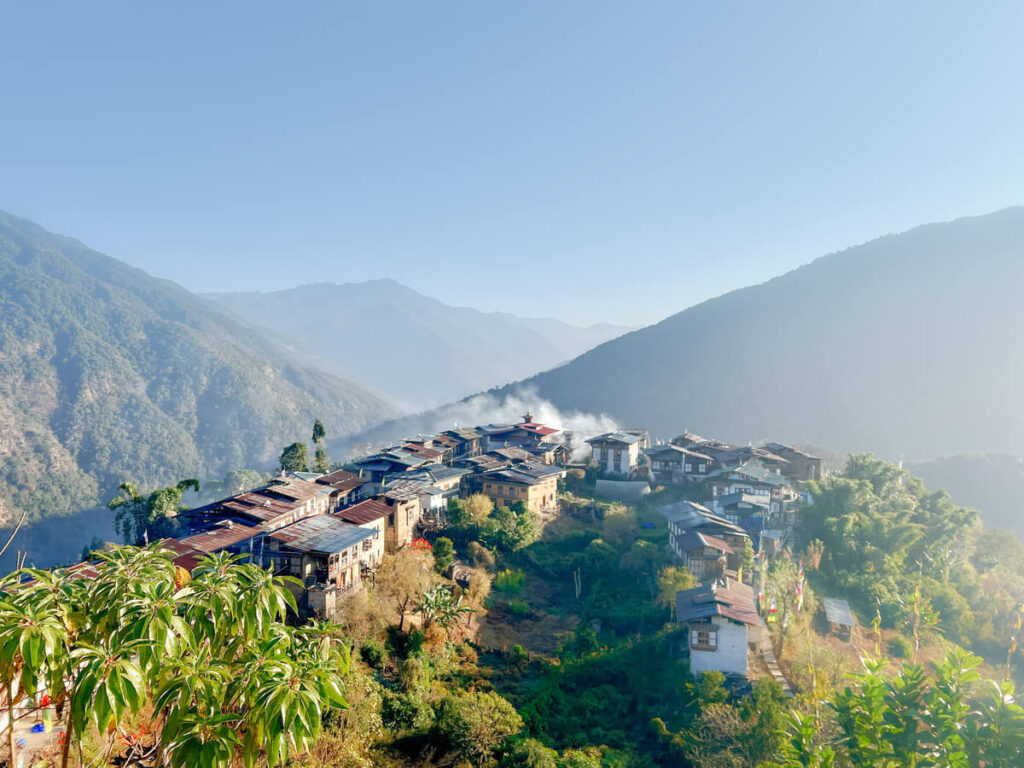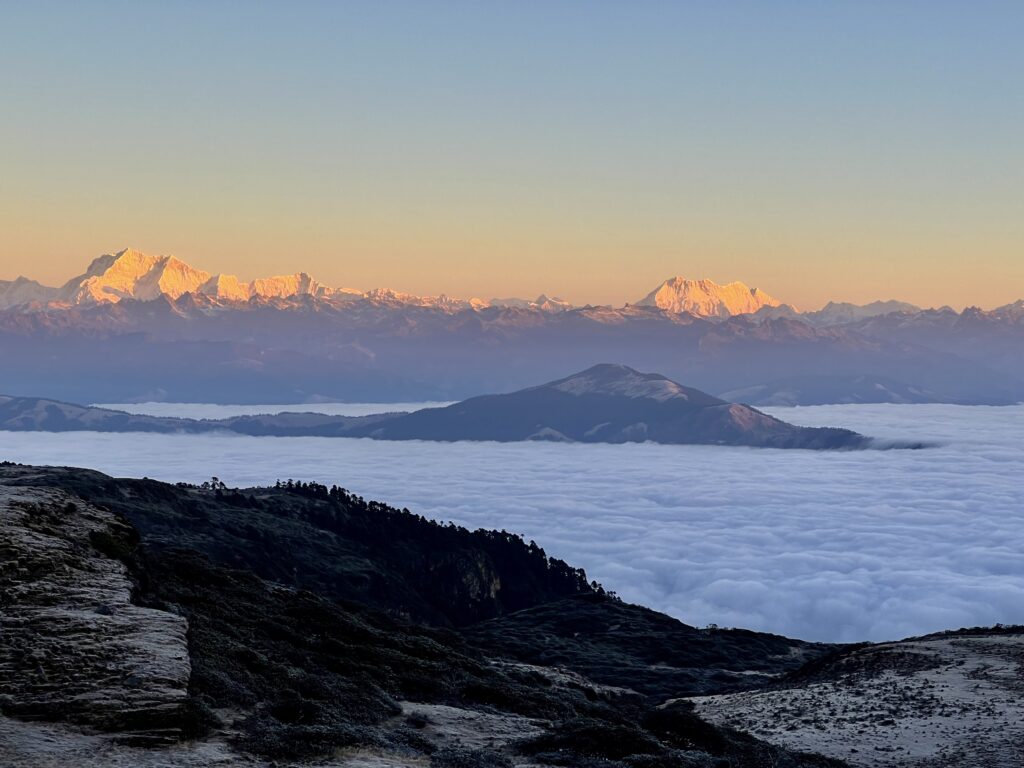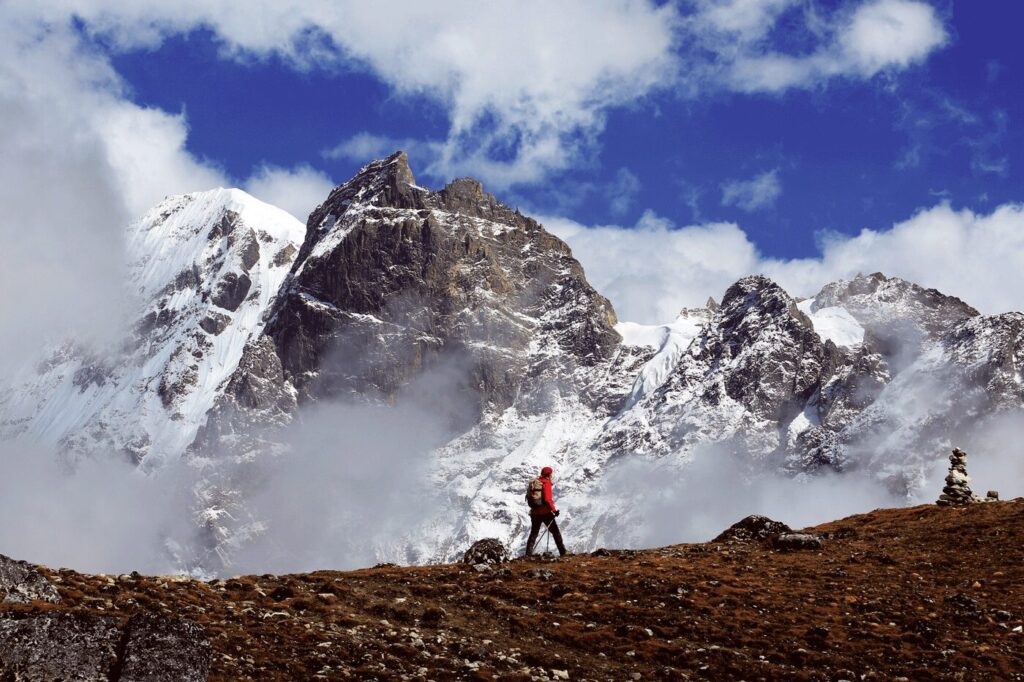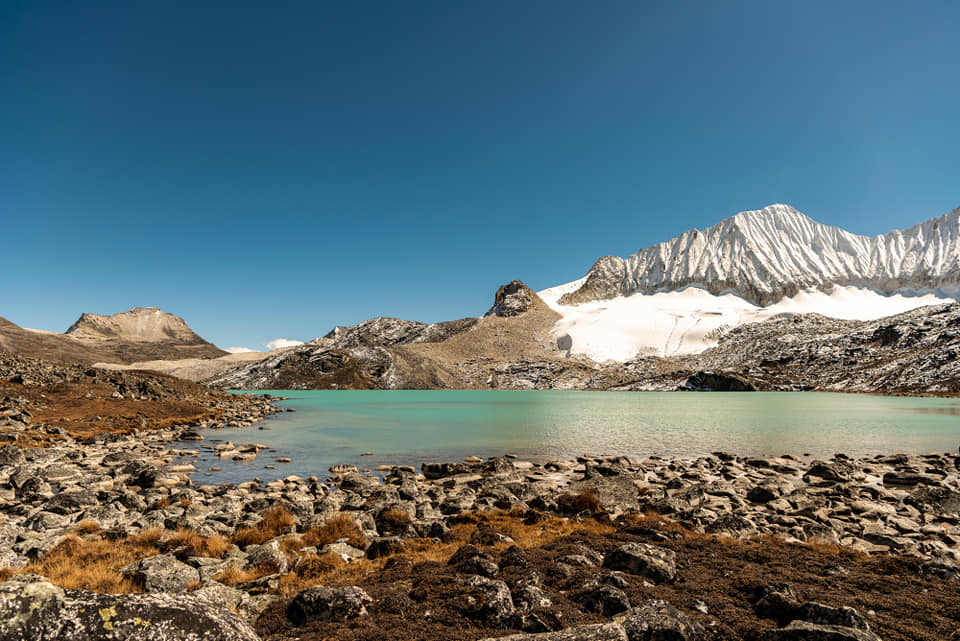Day 01: Arrive in Paro and travel to Thimphu
- Altitude in Paro: 2,300m
- Altitude in Thimphu: 2,400m
- Distance: 55km
- Estimated travel time: 1.30hrs
Welcome to the land of the last Shangri La on Earth. Bhutan is the beautiful gem of the Himalayas, and your next 14 days in the country will be filled with amazing experiences!
Right before landing at Paro International Airport, you will be welcomed with a mesmerizing sight of towering mountains, vast forests and sharp cliffs.
At the Arrival Gate, your personal guide and driver will be waiting and holding a signboard with the name Bhutan Pelyab Tours. Afterwards, we will drive from Paro to Thimphu – Bhutan’s capital city.
En-route, we will stop to visit Tachogang Lhakhang (Temple of The Excellent Horse). This is one of the most remarkable constructions built by Thangtong Gyalpo (1385-1464), a revered saint in Bhutanese culture. The iron bridge with colourful prayer flags leading to Tachogang Lhakhang is its best-known feature. Once there, you can take time to appreciate the quaint surrounding of the temple.
Thimphu became the capital of Bhutan in 1961. It is the largest city in Bhutan with a population of over 100,000 people. The town is set in the hills of Thimphu valley, and stands right next to the great Thimphu Chhu.
After reaching Thimphu, check in and start your visit to the one of the most visible landmarks in the capital – the National Memorial Chorten. It can be recognised from afar for its unique structure and has become a place of daily worship for many Bhutanese. The striking whitewashed chorten with golden finial was originally built by the Third King, Jigme Dorji Wangchuck to pray for world peace. After his death, the chorten began to serve as a memorial to the Third King as well.
From there, we will go to Buddha Point (Buddha Dordenma Statue). With a height of 51.5m, this is the tallest statue in the kingdom, thus you can already see it before reaching the actual site. Walking inside, you will find 125,000 smaller Buddha statues, all made of bronze of gilded in gold.
Wrap up your first day in Bhutan with a visit to the striking and expansive Tashichho Dzong (Fortress of The Glorious Religion). Through the time of more than 8 centuries (from 1216 A.D), the dzong has been damaged and reconstructed a couple of times, and completely renovated by King Jigme Dorji Wangchuck when he moved the capital to Thimphu. Today, it is the main secretariat building which houses the offices of the King and the Throne Room. The large dzong is about 2km from the main town. Moreover, the flag changing at 5pm is a very interesting ceremony to observe. It begins in the courtyard and ends outside in the front of the dzong. This is an event that any visitors to Tashichho Dzong should not miss!
Return and stay overnight at the hotel in Thimphu.
Day 02: Thimphu sightseeing
In the morning, wake up to the fresh air of Thimphu valley. Enjoy breakfast and then we will hike to Cheri Goemba, located at 2,800m above sea level. This landmark has a rich history as the first monastery of the country, founded in 1620. The hike will be about 1 hour with an elevation gain of 400m. We will walk through a beautiful forest of firs, rhododendron trees, and blue pines. The monastery became famous after it was visited by Guru Padmasambava. Thanks of its high spot, you can get a vivid view of Thimphu valley’s nature with a clear river and pristine forests.
If your tour is on a weekend, we can visit the farmer’s market. People gather at the market and sell all kinds of fruits, vegetables, meat, and even incense. These products are grown and brought over from all places in Bhutan.
Learning about Bhutanese heritage and arts is the best way to complete your exploration of this kingdom. Through hundreds of years, their traditions are still preserved very well by the locals and by the government. To gain an insight into the local heritage, we will then discover the Folk Heritage Museum and the National Textile Museum. The heritage museum is constructed as a rural house from the mid-19th century with rammed mud timber and household objects. And you will get to see the practice of thagzo – Bhutan’s art of weaving using different styles and materials at the National Textile Museum.
Later, we will head to the National Institute for Zorig Chusum. Opened by the government, the institute plays an integral role in the preservation and promotion of the traditional arts and crafts of Bhutan. The locals call it the ‘Arts And Crafts School’ or the ‘Painting School’, and students learn traditional arts of Bhutan here. From embroidery, painting to statue-making and more, visitors will definitely be impressed with the skills and disciplines of the students at such a young age. There’s also a gallery where you can see more of the students’ works.
The rest of the day can be spent at your leisure. Thimphu is a bustling town, so you may use the time to explore the stores, restaurants and coffee shops. You can leisurely stroll around to enjoy the atmosphere of the city and watch as the locals go on with their daily business. The nightlife in Thimphu is perfect for those who want to refresh with tasty local dishes, good music, and cool bars.
We will continue staying at the hotel in Thimphu.
Day 03: Thimphu to Punakha
- Altitude in Punakha: 1,300m
- Distance: 75km
- Estimated travel time: 3hrs
Leaving the bustling Thimphu city, we will drive to Punakha, which was the former capital of Bhutan. We will stop for the panoramic view of the Himalayan mountains from Dochula Pass (3,050m). Because of its breathtaking scene from the top of the mountain, the pass becomes popular with travelers to Bhutan. There is nothing that can compare to the feeling of standing from Dochula Pass and looking out to see the magnificent scenery.
On the way to Punakha, we will visit Chimi Lhakhang (Temple of Fertility). Ascending only 20m, which takes about 30 minutes, we will cross hillock fields to visit Chimi Lhakhang at an altitude of 1,500m.
We will stay overnight at the hotel in Punakha.
Day 04: Discover Punakha
In the morning, we will explore Sangchhen Dorji Lhuendrup Lhakhang Nunnery. The stunning temple plus nunnery perches on a ridge overlooking the scenic valleys of Punakha and Wangduephodrang. It houses a 14-foot main bronze statue of Avalokiteshvara (Chenrigzig chagtong chentong). This giant masterpiece is the handiwork of local Bhutanese artisans. Asides from that, the complex also consists of a permanent higher learning and meditation centre for the nuns.
Next, we will visit Punakha Dzong, or the ‘Place of Great Happiness’. Regarded as one of the most spectacular dzongs in Bhutan, this landmark has witnessed some of the most important moments in the history of Bhutan. Punakha Dzong offers a great view of the Pho Chhu and Mo Chhu, since it stands right at the confluence of the 2 rivers.
Arriving at Pho Chhu Suspension Bridge, we can enjoy the wonderful sight of Punakha Dzong and Pho Chhu Valley. With 160m in length, it is the longest suspension bridge in Bhutan.
In the afternoon, hike to Khamsum Yuelley Namgyal Chorten (1,500m), which stands proudly on a ridge above the Punakha Valley. From the suspension bridge, we will ascend 200m up the hill. The hike is only about 1 only, and despite the trail maybe a bit muddy, it’s an easy walk. Khamsum Yuelley Namgyal Chorten is one of Bhutan’s finest architectural examples, also the only one of its kind in the world. The building is a pagoda-style stupa with 4 stories, and various smaller pagodas surrounding it.
Afterwards, we will rest at a hotel in Punakha.
Day 05: Punakha to Gangtey
- Altitude in Gangtey: 2,900m
- Distance: 87km
- Estimated travel time: 3hrs
Leaving Punakha, we will continue to the town of Gangtey. Set close to the centre of Bhutan, Gangtey is in a remarkably attractive glacial valley called Phobjikha.
In Gangtey, we will visit the famous Gangtey Goemba or ‘Gangtey monastery’. This was the only Nyingmapa monastery in the Black Mountain region when first built in 1613, and today it remains the largest Nyingmapa monastery in the western land. From the impressive building, you will have the breathtaking views of Gangtey valley with stretches of green fields, untouched forests and great surrounding mountains. The land of Gangtey is also known as the home of the rare Black-necked Cranes in the winter when they migrate from the higher altitude plateaus of the Tibetan region.
Next, follow the Gangtey Nature Trail. This is a very enjoyable hike for visitors, since it offers picturesque views with the pleasant experiences of discovering the pristine wildlife of Phobjikha valley. When walking among the trees, you will feel relaxed and connected to nature. En route, we will pass prairies, flower meadows, farmhouses and beautiful jungles, then descend to a scenic valley viewpoint and finish at the small Khewang Lhakhang (Khewang temple). The building is located opposite a local community school, and is one of the oldest temples in the valley, from the 15th century.
While we are here, you can spend time learning archery. A trip to Bhutan would not be complete without trying the two most popular sports of Bhutan. Both sports are a fun way to spend an afternoon with the locals, enjoying some healthy competition with their family. Your guide and driver will be happy to teach you the basic techniques.
Lastly, we will visit the Black–necked Crane Visitor Centre, which is located close by. The centre focuses on sustainable ecotourism activities, environment education, and conservation programs in Phobjikha valley. The building’s location allows people to overlook the wetlands, which is the Black-necked crane’s winter habitat.
Tonight, we will rest at the hotel in Gangtey.
Day 06: Gangtey to Bumthang
- Altitude in Bumthang: 2,800m
- Distance: 158km
- Estimated travel time: 6hrs
Today, we will explore the spiritual heartland of Bhutan – Bumthang. Bumthang consists of four main valleys – Tang, Ura, Choekhor and Chumey. The region of Bumthang is home to a number of Bhutan’s oldest palaces, Buddhist temples and monasteries with striking architectures.
With a break amid the long drive to Bumthang, we will spend some time at the historic Ta Dzong, the famous watchtower which once guarded Trongsa Dzong from internal rebellion. After completing its mission of protecting the land, it now serves as the National Museum with impressively large collections dedicated to the Wangchuck Dysnasty. We can gain valuable knowledge about the kingdom’s history here as the information is very well presented and the items are quite diverse with ancient relics and statues of deities.
After visiting the old watchtower, we will come inside Trongsa Dzong. It has a strategic location, sitting high above the roaring Mangde Chhu river. Built in 1644, the complex is perhaps the most spectacular dzong in the country, and it is easy to see why the moment we arrive here. From afar, Trongsa Dzong is a striking architecture with a sheer drop to the south that disappears behind the thick veils of clouds. The buildings trail down the ridge and are connected by a succession of alley-like corridors, with wide stone stairs and lovely paved courtyards. Trongsa Dzong is so massive that it is easily visible from anywhere in town, thus remains a captivating sight to behold for visitors and locals.
In the afternoon, we can explore the activities in the Yathra Weaving Center. At the weaving center, you can understand more about the intriguing process of weaving yathras, the local’s unique woven textile with deep colors and eye-catching designs. Besides, we will drive slowly and make stops for refreshments and sightseeing at certain spots.
We will return to Bumthang town and stay overnight at the hotel.
Day 07: Bumthang sightseeing
The first site to sightsee in the morning is the renowned Jambay Lhakhang, one of the holy temples built by the 7th-century Tibetan king Songtsen Gampo. It is said the temples were erected in 659 in only one day to subdue a Tibetan demoness, and her left knee was pinned down by Jambay Lhakhang. Sometime after that, Guru Rinpoche visited the ancient temple and the Sindhu Raja renovated it after the Guru restored his life force.
We will then visit the imposing temple complex Kurjey Lhakhang, consisting of 3 buildings, namely Guru Lhakhang, Sampa Lhundrup Lhakhang and Ka Gon Phor Sum Lhakhang. The sacred site is where the body (kur) print (jey) of Guru Rinpoche is preserved, located in a cave in Guru Lhakhang, also the oldest of the three buildings in the complex. There is also a big cypress tree behind the temple, which is believed to have sprouted from Rinpoche’s walking stick.
Near the Kurjey Temple is Kurjey Drupchu, where the holy water can be found. Kurjey Drupchu is believed to have been blessed by Guru Rinpoche himself.
Later, it is up to you whether we drive or walk for 1 hour to Tamshing monastery. The building, formally called Tamshing Lhendup Chholing (Temple of the Good Message), is the most important Nyingma Goemba in Bhutan. Established in 1501 by the great spiritual master Pema Lingpa, the site remained privately owned by his descendants and only opened to the public since 1960. The strange structure of the building was erected by Pema Lingpa himself, with the help of Khandromas, who had made many of the statues. It is one of the few institutions continuing the teachings of Pema Lingpa.
Before returning to the hotel, we will discover Lhodrak Kharchu Monastery. The sacred monastery was the seat where Nub-ben Namkhai Nyingpo Rinpoche became an accomplished Yangdag master. The edifice was established in the 1970s and you will find large statues of Guru Rinpoche, Chenresig and Sakyamuni in its Tshokhang (assembly hall).
We will stay for another night at our hotel in Bumthang.
Day 08: Manchugang – Dhur Village
- Distance: 6-7km
- Estimated time: 4-5hrs
- Camp altitude: 3,450m
After breakfast, we will drive to Manchugang to start the Bumthang Owl Trek – the highlight of this tour.
Starting from Manchugang, we will continue to Dhur village. With a population of around 800 people, this is the biggest village in Bumthang (2,900m above the sea level). The villagers are the nomadic Kheps and Brokpas and speak two distinct dialects, the Bumthang Kha and the Brokke (nomadic dialect).
En route, we will pass a traditional water-driven flour mill near the river, which was once used by the villagers. The trek will resume with an uphill hike through blue pine forests. We will arrive at the campsite at Schonath (at 3,450m), amidst hemlock and juniper trees. The silent nights are punctuated by owl hooting, thus the ‘The Owl Trek’. If the sky is clear, you can also observe the stars.
Tonight will be quite different as we spend the night at the campsite.
Day 09: Dhur Village – Drangela Pass
- Distance: 6-7km
- Estimated time: 4-5hrs
- Camp altitude: 3,870m
The second day of this trek will be mostly through virgin forests of huge hemlock, fir, spruce trees and species of rhododendrons, which are in full bloom during the months of April and May. The trail will also lead through bamboo forests, which is the main undergrowth in this area.
After 2 hours of trekking, we will arrive at Drangela Pass (3,600m). HIking up the Kitiphu ridge will bring us to the night camp at an altitude of about 3,870m. From this point, we can have a striking view of the mountains and beautiful valleys underneath. Moreover, from the campsite, travelers can enjoy the amazing sight of Mount Gangkhar Puensum (7,541m), the highest mountain of Bhutan and is also the highest unclimbed peak in the world.
We will spend the night at the camp.
Day 10: Drangela Pass – Tharpaling monastery
- Distance: 6km
- Estimated time: 4 -5hrs
- Camp altitude: 3,870m
On day three, we will descend towards the monasteries of Zambhalha, Choedrak and Tharpaling. Chuedak monastery has 100 Avoloketeshvaras in the form of Chukchizhey (eleven heads) that cannot be seen elsewhere in Bhutan. Here visitors can pray for themselves and all living things.
Tharpaling monastery was founded by Longchen Rabjam (1308- 1363), the great philosopher of the Dzogchen, a religious movement of the Nyingmapa school. Later, this monastery was used as a place of meditation of other great figures – Jigme Lingpa, Nyoshul Khen Rinpoche and Dilgo Khyentse Rinpoche. Inside, there are statues of Longchenpa and Jigme Lingpa in meditation posture and frescoes of the lineage of Longchenpa and Jigme Lingpa.
Right above Tharpaling monastery, we will see Choedrak, where Guru Rinpoche had meditated at. For this reason, Lorepa – a lama from Tibet decided to live and build a temple there in 1234.
In the afternoon, we will relax and wait to see the marvelous sight of sunset on the horizon.
Overnight at the campsite. The next day, wake up early and we will also be rewarded with the beautiful sunrise. Enjoy the fresh air and the first touch of sunlight from the campsite.
Day 11: Bumthang sightseeing
In the morning, a private car will be waiting at the campsite to take us back to the hotel.
On the way, we will see the holy Mebar Tsho (The Flaming Lake). The sacred lake is located along the way to Tang village. The story of Mebar Tsho is related to the respected religious treasurer Terton Pema Lingpa. Pema Lingpa is considered an incarnated disciple of Padmasambhava who discovered treasure within the lake in late 15th century.
Bumthang Brewery and Bumthang Swiss Cheese Factory will be our next interesting stops, both were established by Frits Maurer and now run by his children. Maurer, a Swiss immigrant, was Bhutan’s first foreign traveler and invited by the King himself. Travelers are often surprised since they do not expect to find Weiss beer right in the heart of Bumthang valley. The brewery is famous for their Red Panda Weise Beer, the beer is brewed in an old school way and preservative-free. Thus, there are only 3000 bottles produced per month, and all are recycled back in production.
Next to the brewery is Bumthang Cheese Factory, which has been producing Swiss cheese since the 1960s. The fresh milk is collected from distant villages and carefully checked so that the factory can have the best cheese. Seeing the process of beer brewing and cheese making can be quite fascinating experiences, and you will get a bottle of your own and be able to try some of their cheeses. You may also buy some cheeses as souvenirs (also apple brandy and clover honey are sold in their shop), your family and friends will surely be excited to try the Swiss cheese produced in Bhutan!
We can sightsee Jakar town in the afternoon. It is the district capital of Bumthang, a bustling little one-street town with an abundance of restaurants and handicrafts stores. Jakar has a rich religious history since it was the first place Guru Rinpoche arrived in Bhutan, and subsequently is accorded the title of the birthplace of Buddhism in the country!
We will stay overnight at the hotel in Bumthang.
Day 12: Bumthang to Paro
Today, we will fly back to Paro, it’s a short 35-minute flight.
In the afternoon, we will discover the outstanding Paro Rinpung Dzong (Fortress of The Heap of Jewels), a wonderful example of Bhutanese architecture with a complex of courtyards, temples, offices and an accommodating area surrounded by towering walls. The edifice sits on a steep hillside, which offers terrific views of Paro valley. And no matter where you are in Paro valley, you can always see the dzong.
The next dzong will be just as appealing as our first attraction – the National Museum of Bhutan. This was once called Ta Dzong, and it has a prime position on top of the hill to watch over Paro Dzong. Thus, it offers visitors a wonderful view of the valley. Turned into a museum in 1968, Ta Dzong’s collection includes a large number of antique thangka paintings, weapons and armor, and a rich diversity of natural and historic artifacts.
Kyichu Lhakhang, one of the oldest and most sacred temples in the country, will be the next site we visit. It is believed that the Tibetan King Songtsen Gampo had built 108 temples around the Himalayas in the 7th century to defeat a powerful ogress, and Kyichu Lhakhang was one of them. The main relic includes a statue of future Buddha Jowo Jampa (Maitreya) and a statue of Buddha Sakyamuni.
You will be free to wander and visit the cool pubs and various shops in the area after returning to Paro town. The town provides fun nightlife for travelers with amazing live music and mouth-watering snacks and local alcohol for one to try out.
Tonight, we will stay at the hotel in Paro.
Day 13: Discover Paro
“If you have never been to the Tiger Cave Temple, your trip to Bhutan is not complete.” This statement emphasizes the importance of the sacred Taktsang Monastery (or ‘Tiger’s Nest’) to the Bhutanese, and this is true. On a pilgrimage in Bhutan as well as in the Himalayan, this place is one of the most venerated places for monks and Buddhists.
Because Taktsang monastery stands on a steep cliff at 3,000m above sea level, the hike to the monastery will take approximately 4-5 hours. The trail is 4.5km one way, and has an elevation gain of 900m. We will start the trip early in the morning, and throughout the hike, there will be breaks for you to admire the incredible views of Paro’s pristine landscape, from the emerald green valleys to the snow-covered Himalayan peaks. The unparalleled natural scenes are some of the most precious memories of travelers about Bhutan. After sitting down and watching over the picturesque landscape below, you will forget about the tiredness and feel energized to continue.
The rest of the morning will be for the exploration of the monastery. We can walk around to observe the luxurious interior design with gold-plated dome and golden god and deity statues.
We recommend taking a nice hot stone bath to relax your body. In olden days, Bhutanese families soaked in the stone bath after farm work. It is believed that the heat of the water, the minerals released from the rock, and the local herbs all combine to produce medicinal benefits for joint pains, hypertension, stomach disorders and arthritis.
In the later afternoon, we will have a special meal with a local family. This is a good opportunity to interact with the locals while tasting the authentic and delicious Bhutanese dishes. You will have dishes of Ema Dashi, red rice, Jasha Maru, or Phaksha Paa, all are Bhutanese signature food. We will also sleep in Paro for the last night.
Day 14: Depart Paro
After a good breakfast at the hotel, your guide will accompany you to the airport for flight to your onward destination. Tashi Delek (goodbye and good luck) and we hope to welcome you to Bhutan again!
